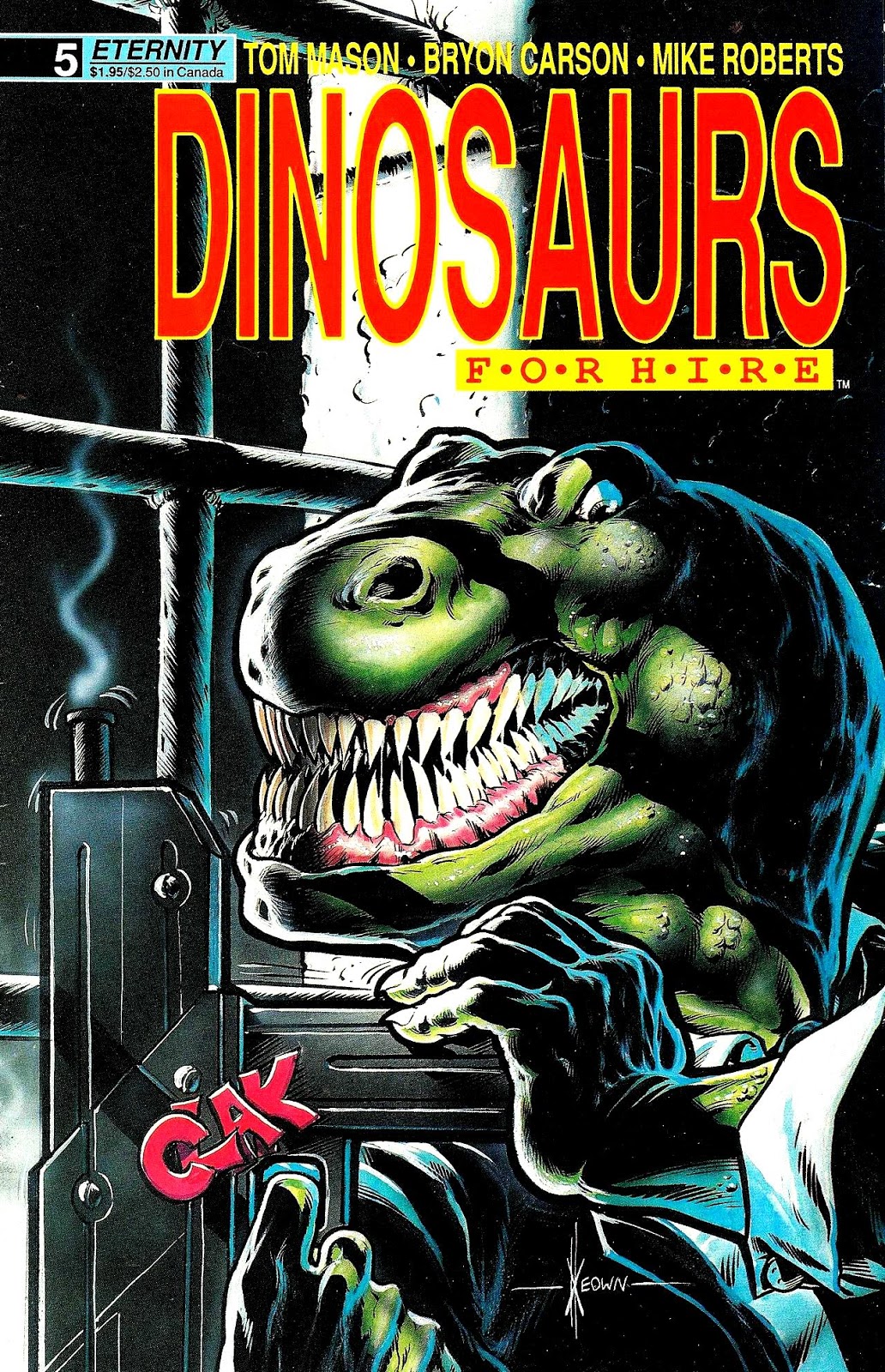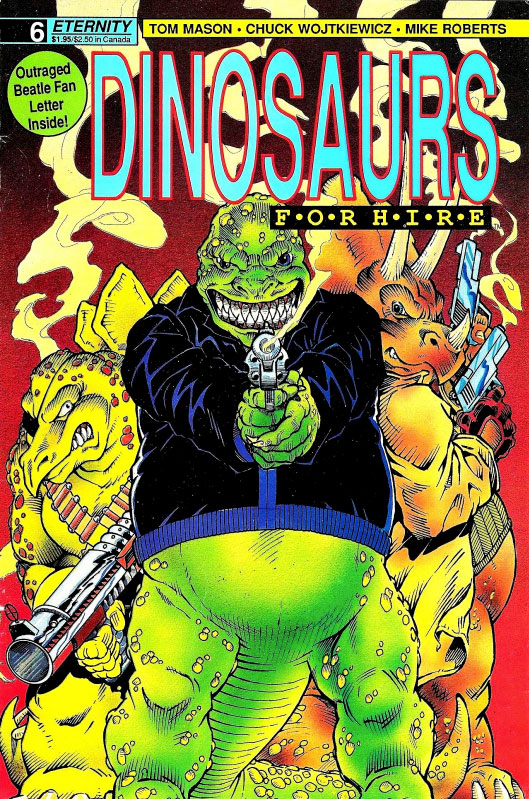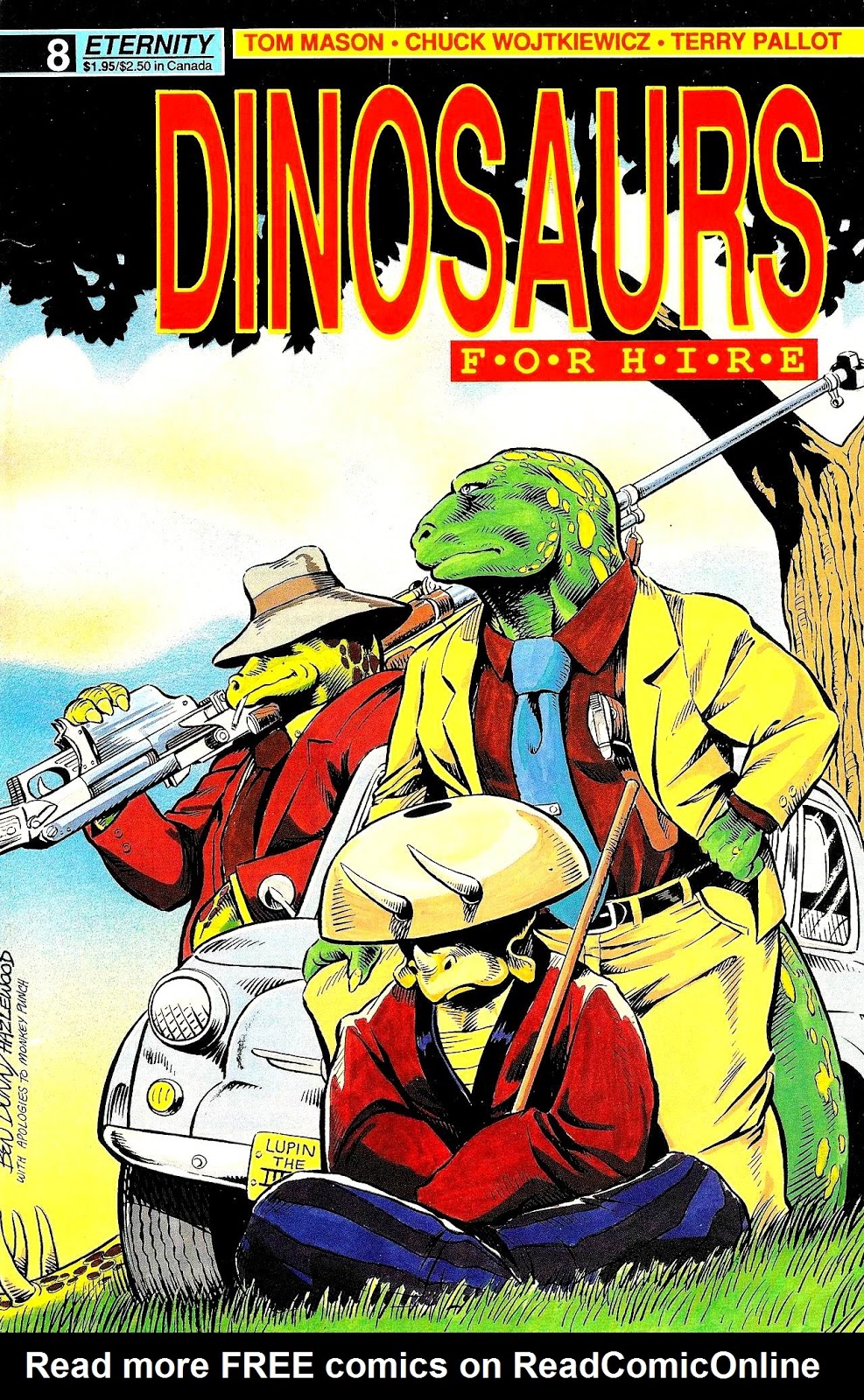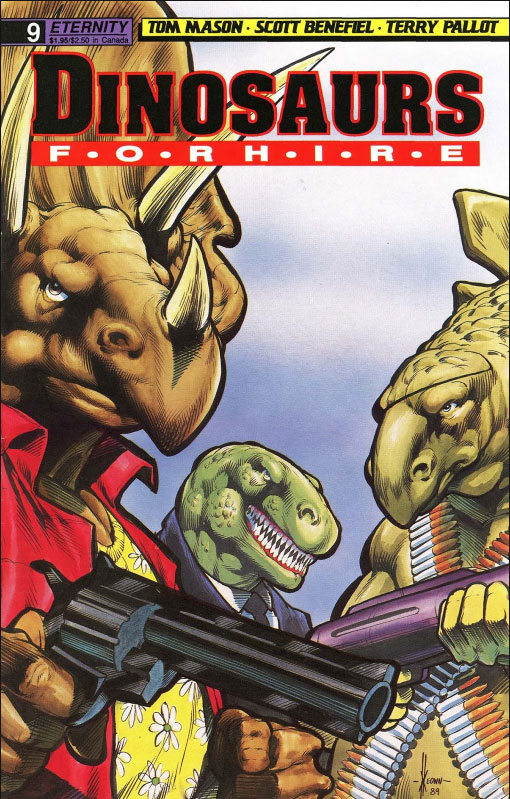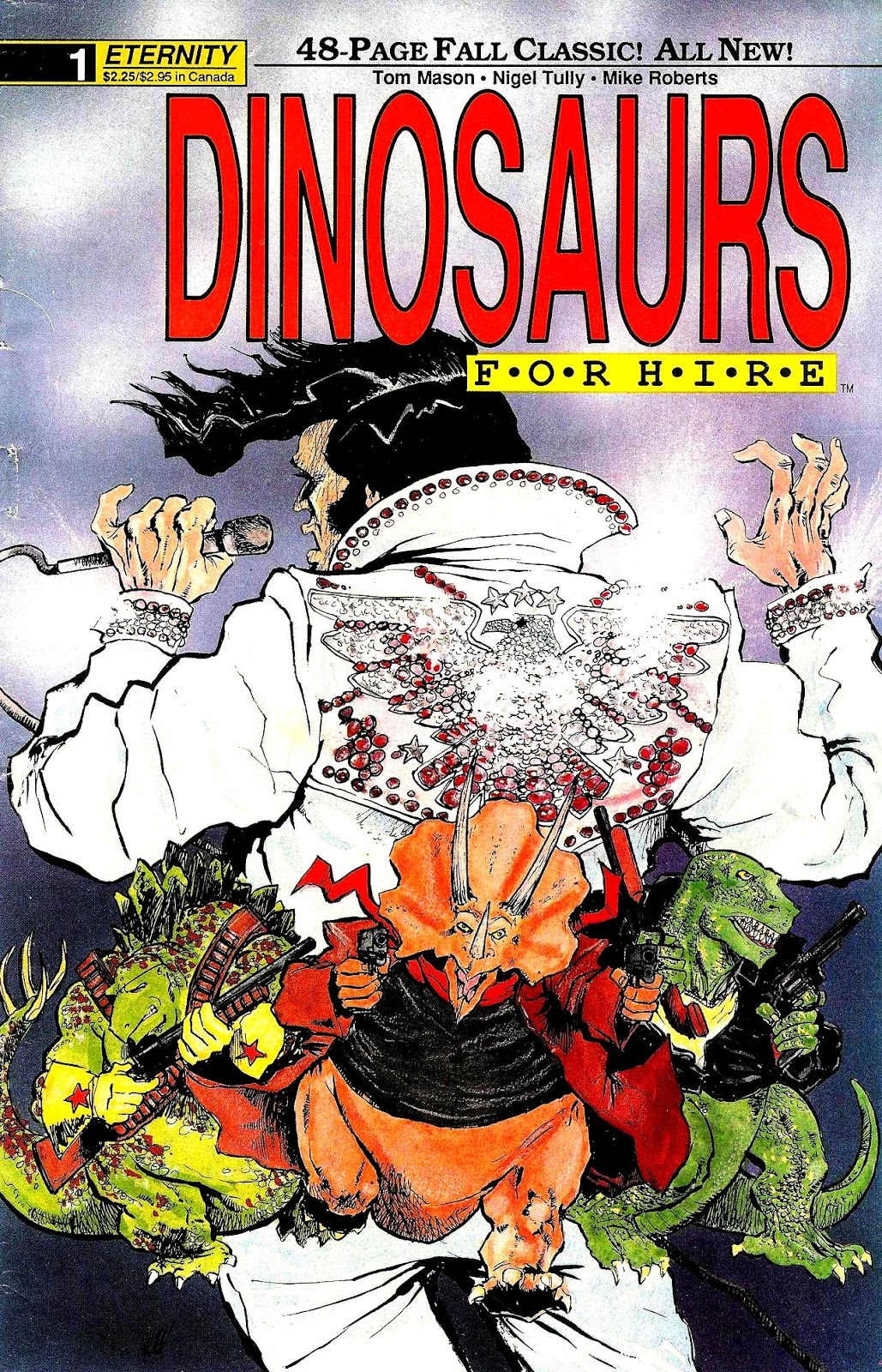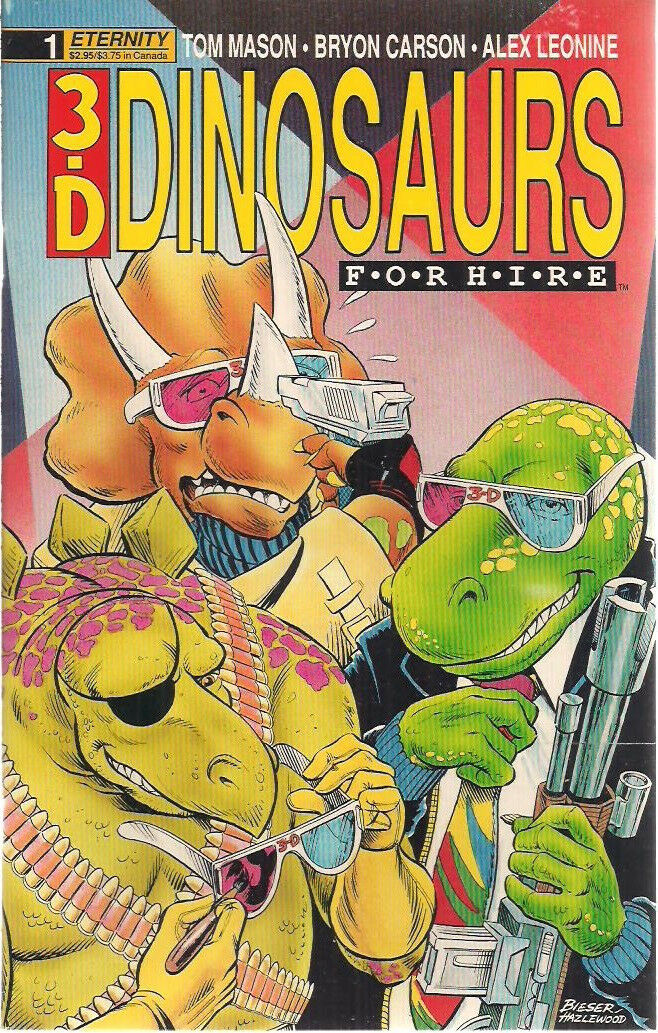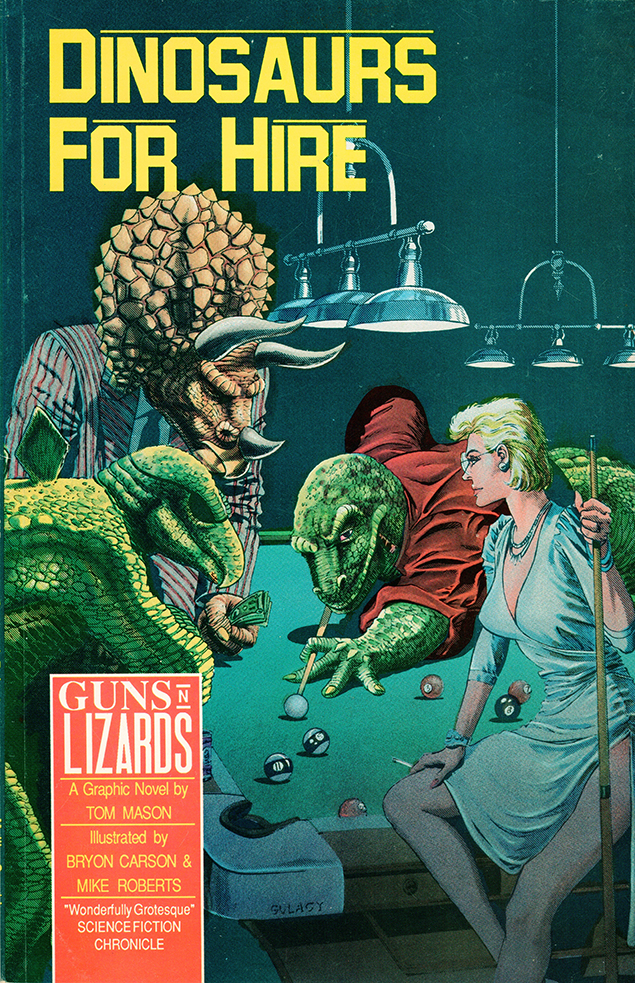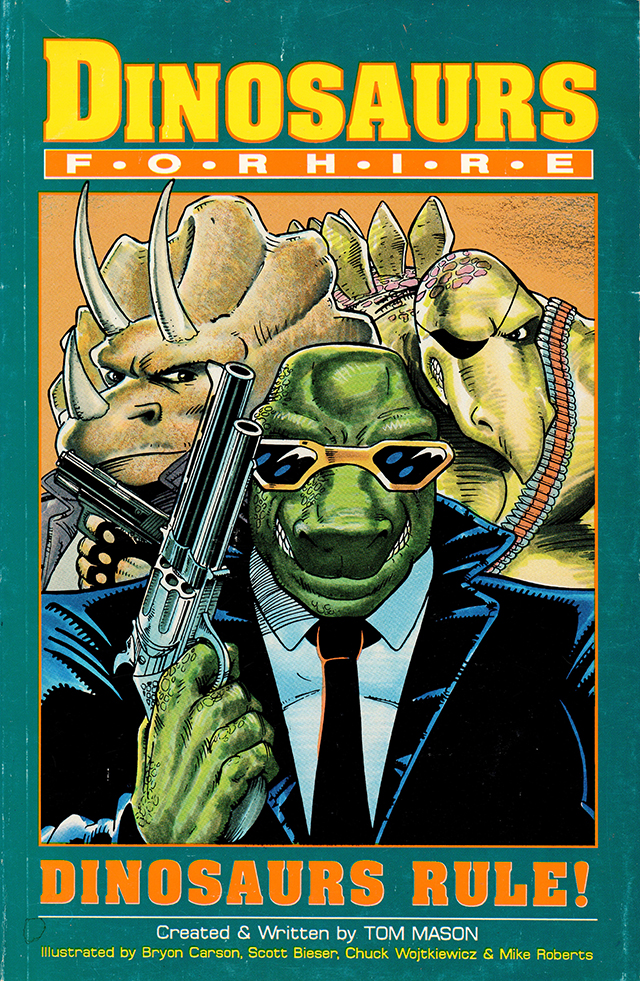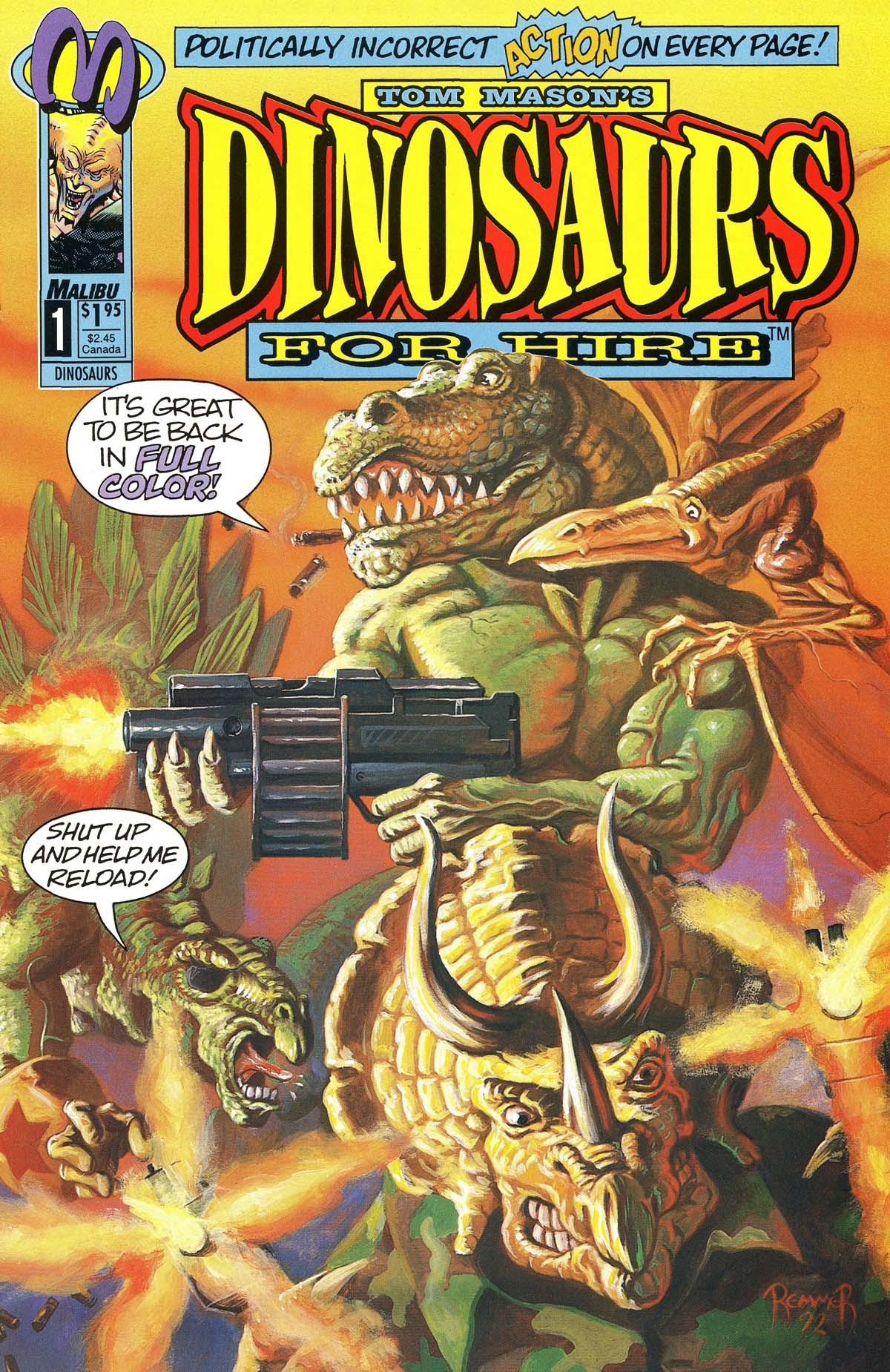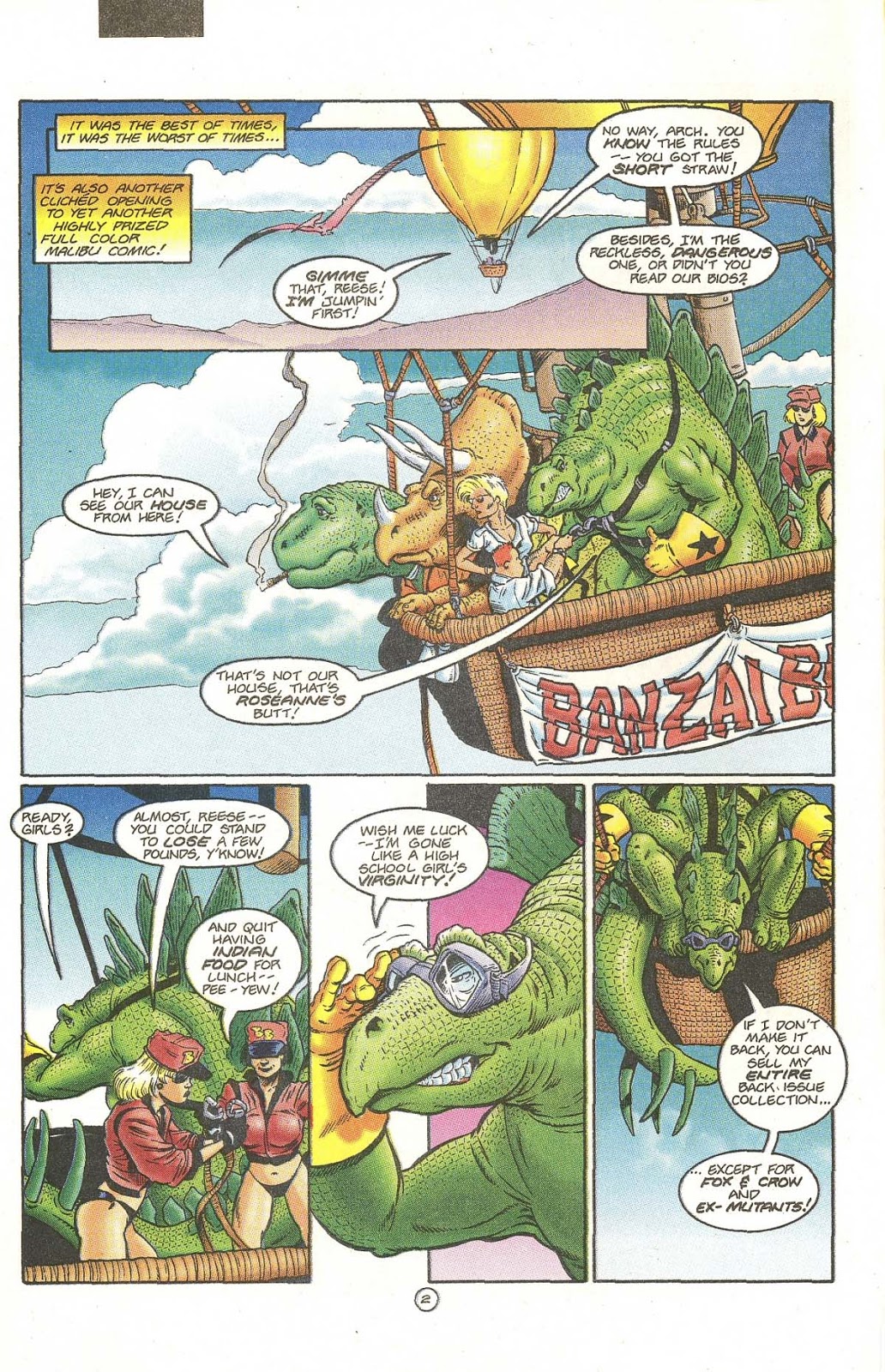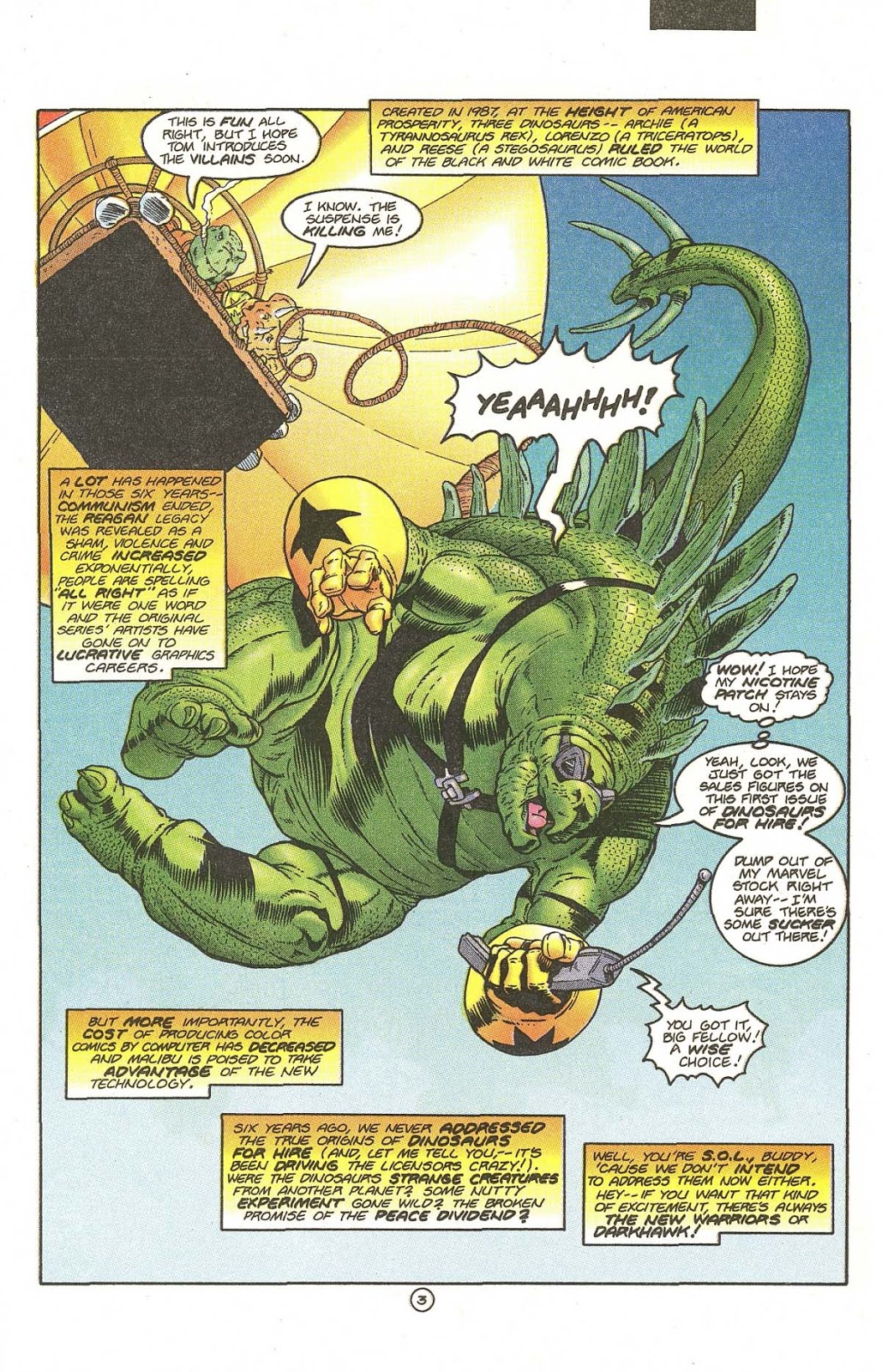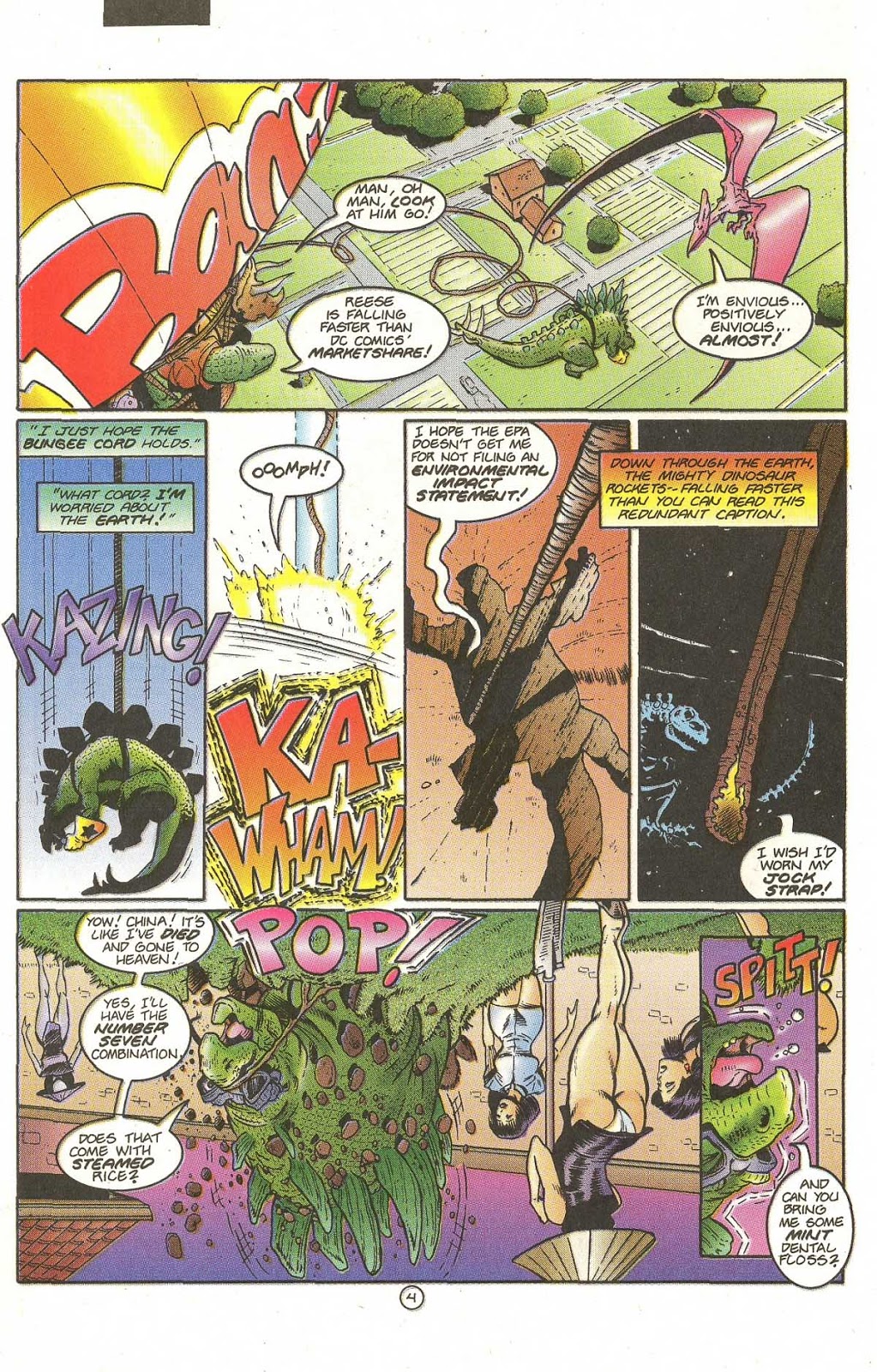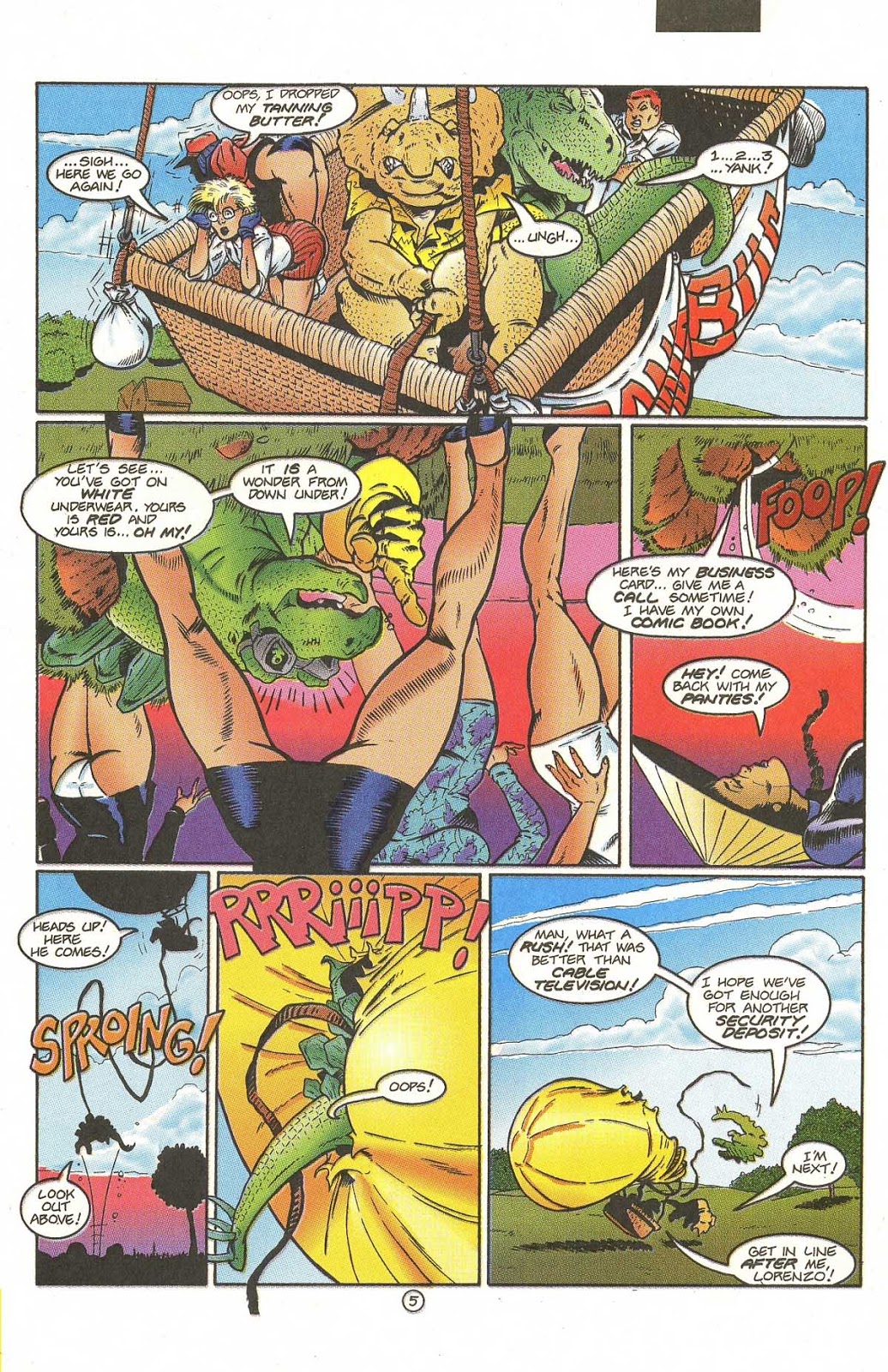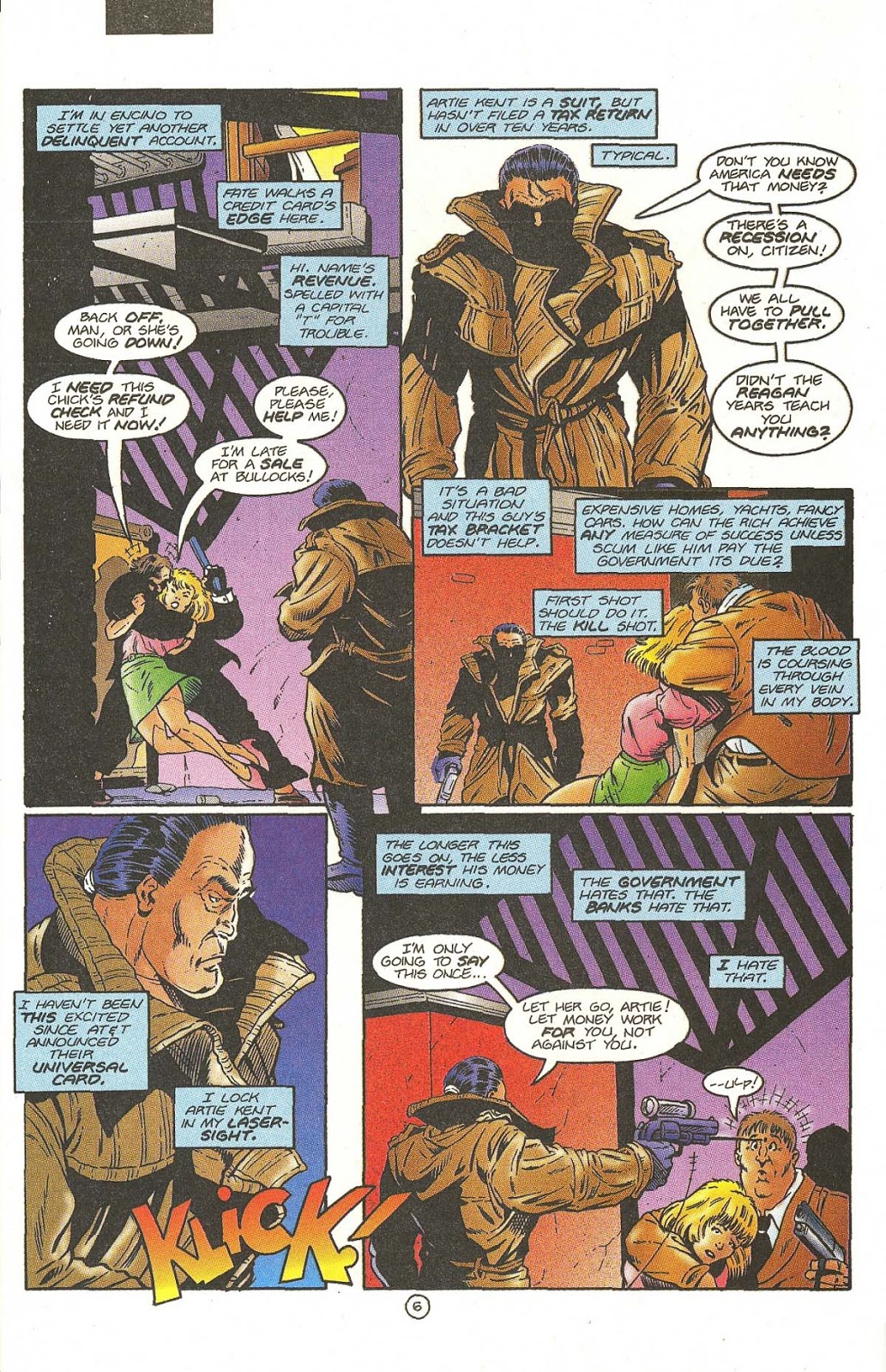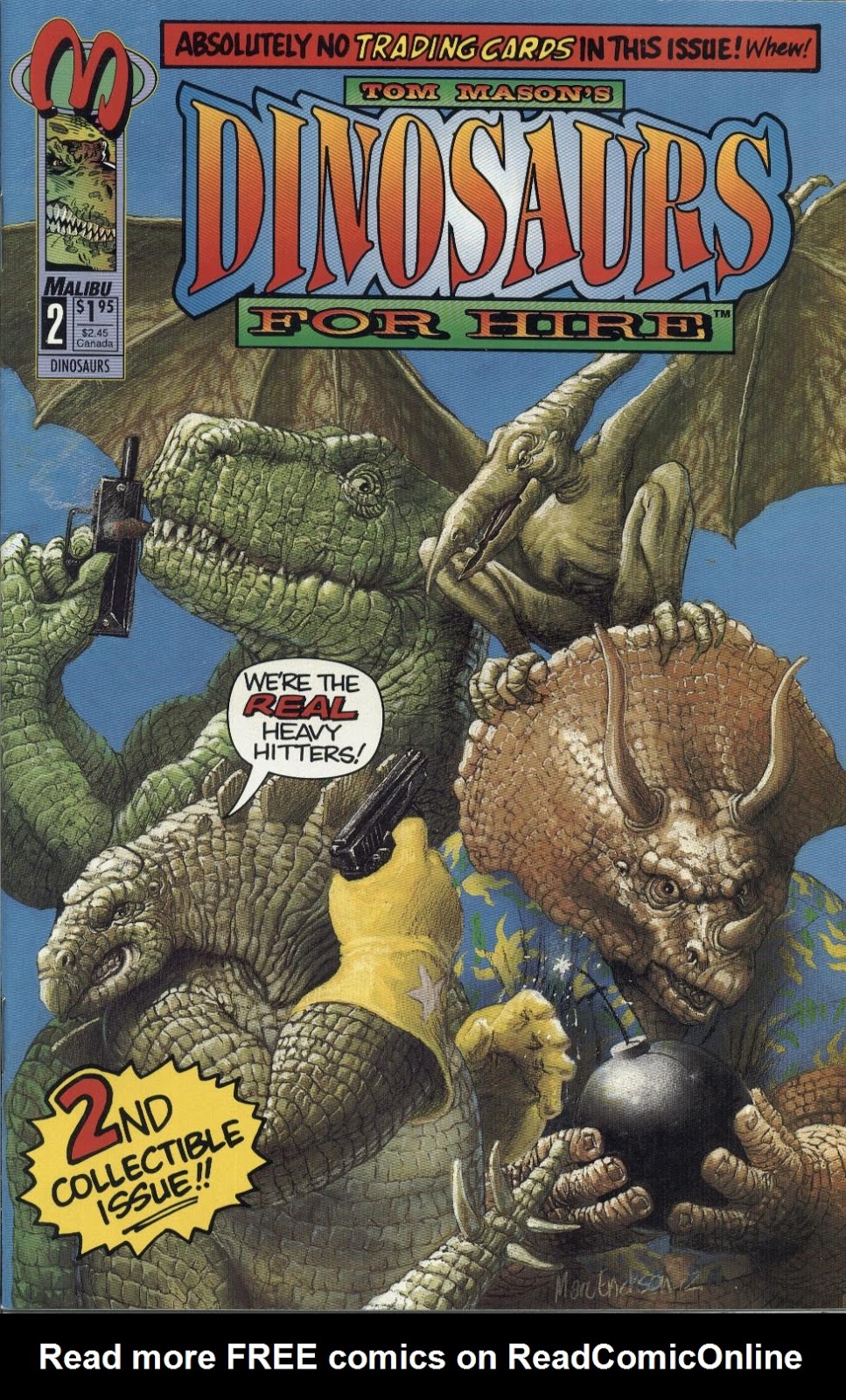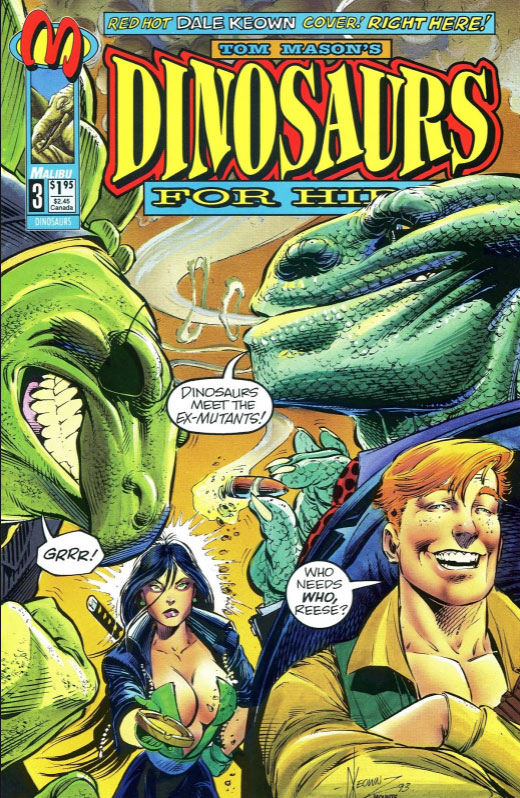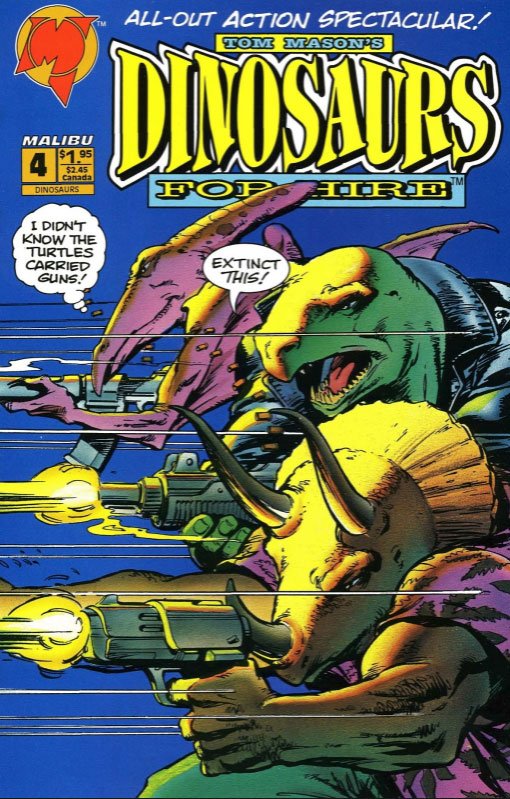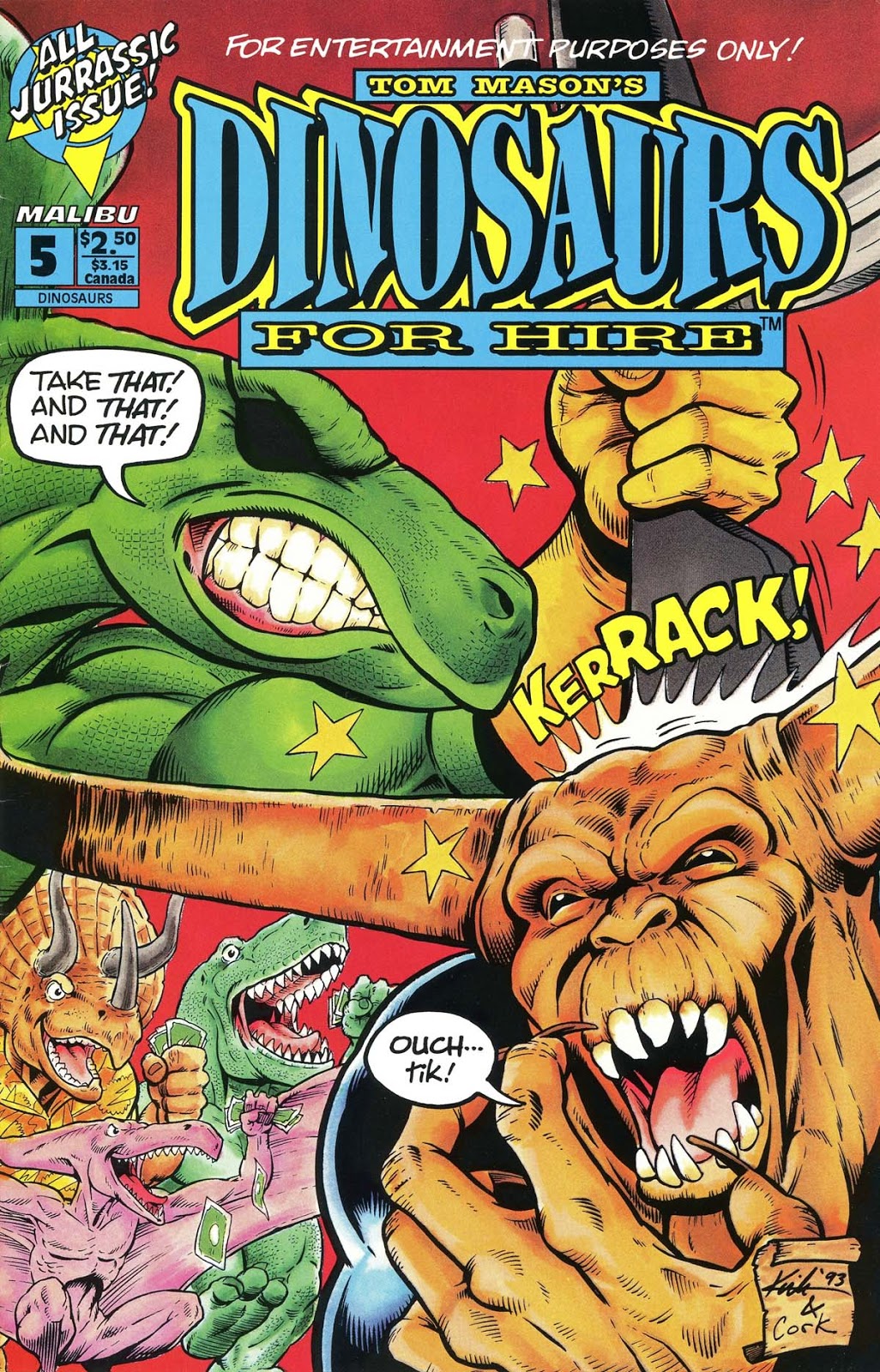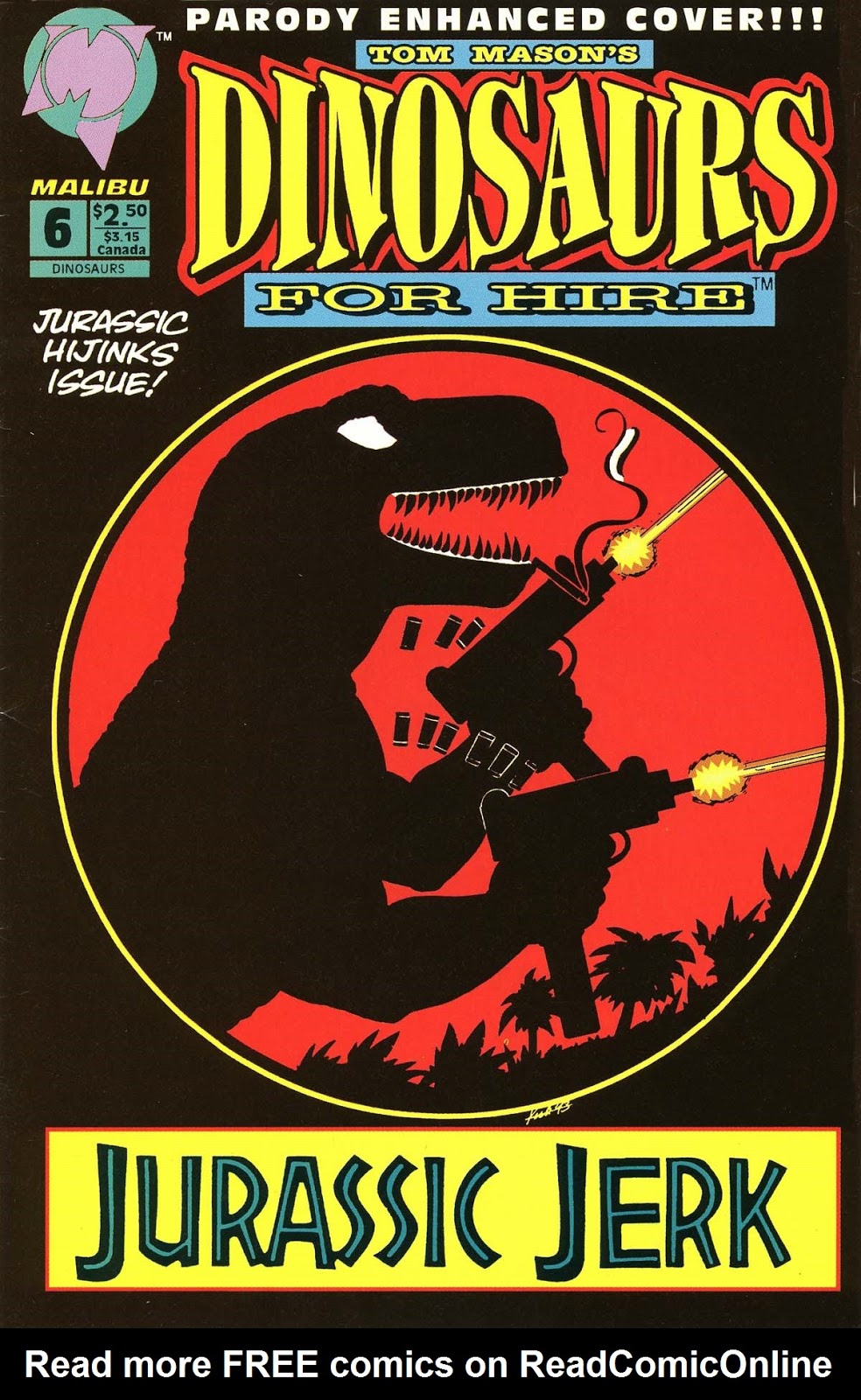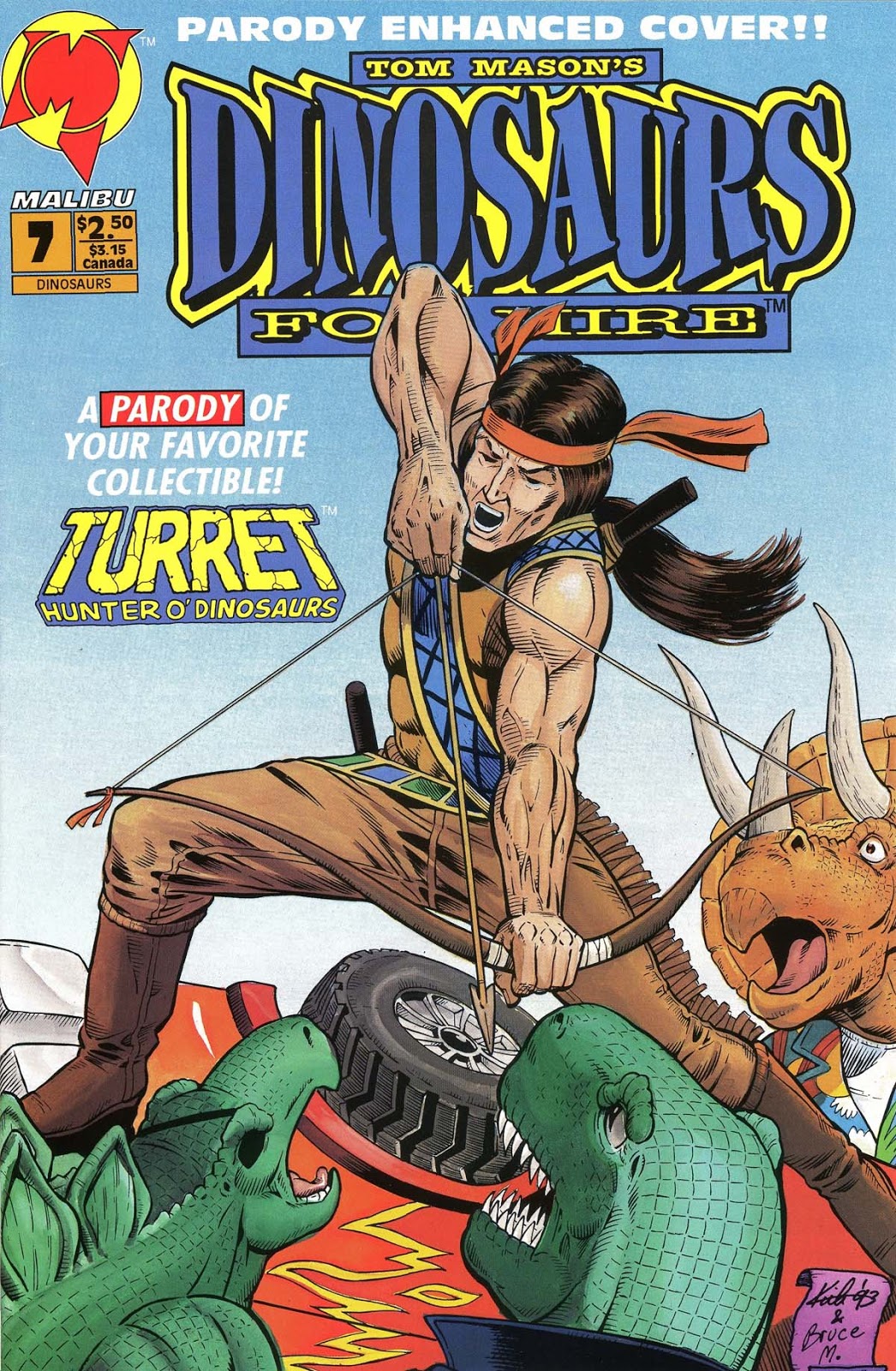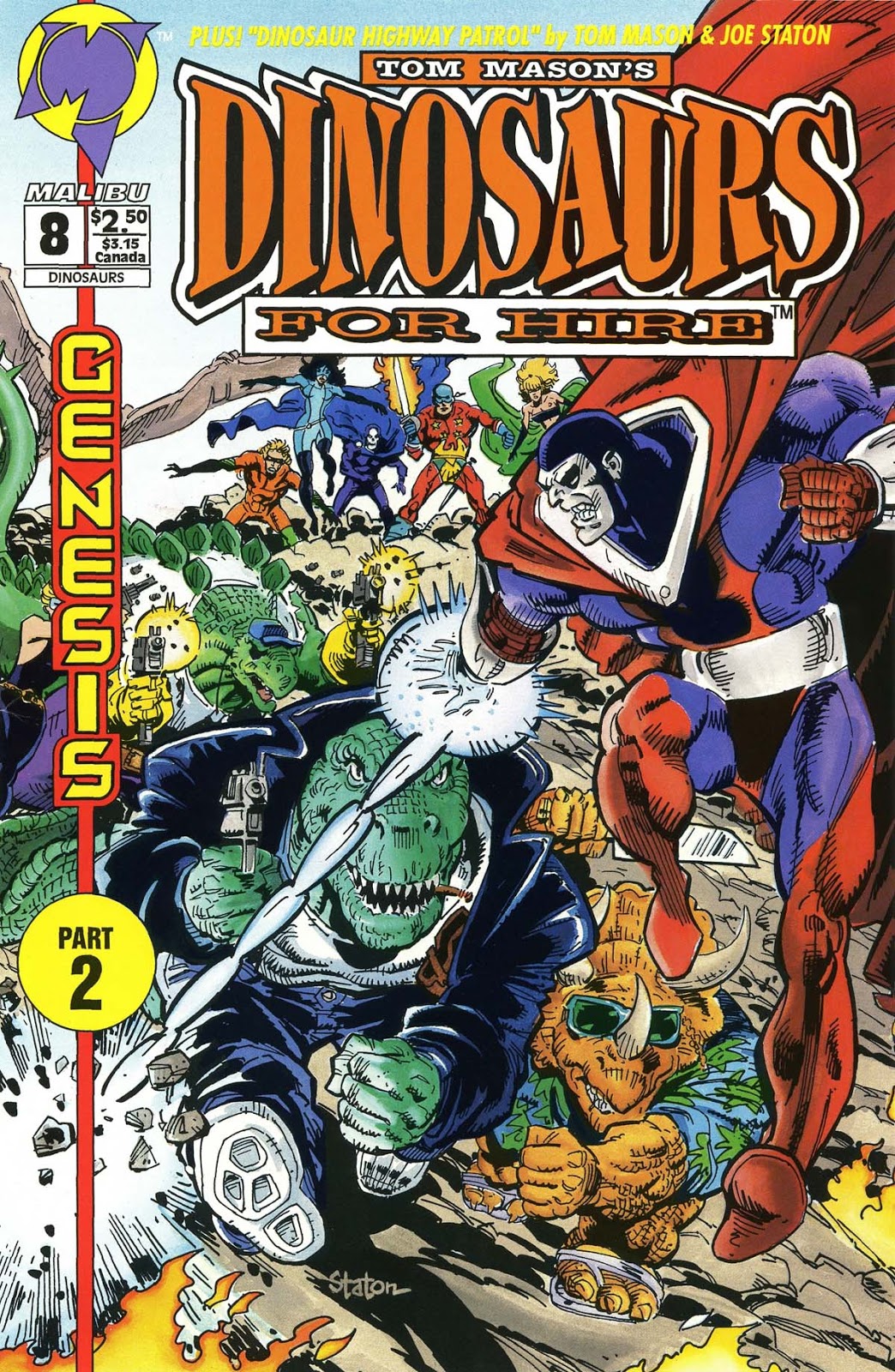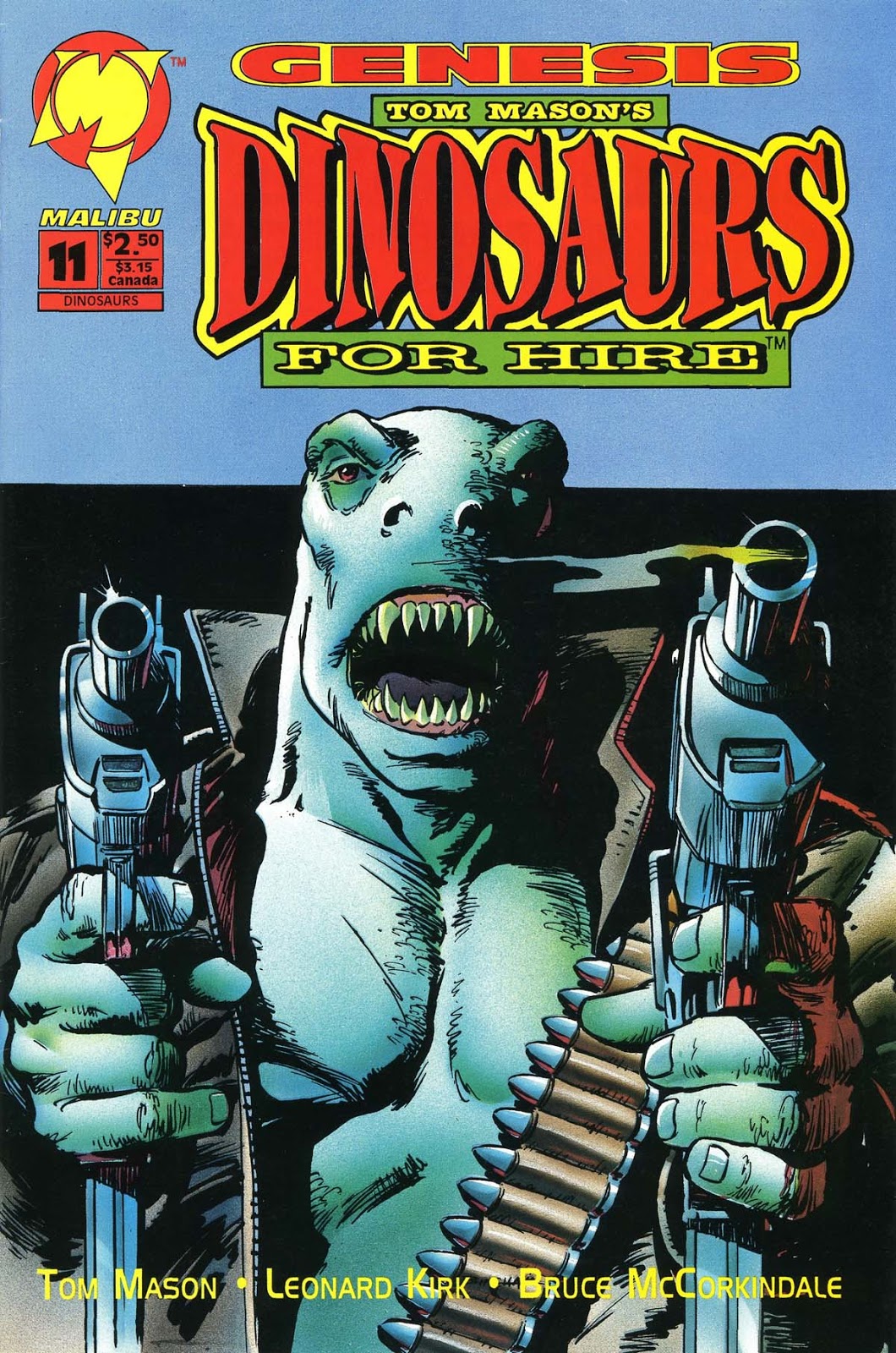
Tom Mason was one of the founders of Malibu Comics, the founding editor of its creator-owned imprint, Bravura, and an original founder of their Ultraverse line. Since leaving comics, he’s worked extensively as a writer and story editor in television. Along with fellow Malibu veteran Dan Danko, he has written or chaperoned 500 episodes of animated television, and they took home an Emmy in the process. He also he co-writes the Captain Awesome books for Simon & Schuster under the pseudonym Stan Kirby, and serves as a consultant for Space Goat Publishing.
Paralleling the early days of Malibu, Mason developed a creator-owned title called Dinosaurs For Hire, which featured a trio of walking, talking, thinking dinosaurs who worked for the federal government and who packed what seemed like an inordinate amount of firepower in just about every situation. The original black and white series, later followed by one in full color, captured the imagination of our J.C. Vaughn well before he was ours, and actually helped set him on the path to Gemstone Publishing’s door. Which is to say, you can blame Tom Mason and Dinosaurs For Hire for everything since.
Vaughn interviewed Mason for this piece.
Scoop: Dinosaurs For Hire is what put you on the map with me, Tom. What had you done up to that point?
Tom Mason (TM): I’d been around, but not where people would know me. I’d been a cartoonist and had my work published in Playboy and Cosmopolitan. I was an art director at Fantagraphics where I created the humor magazine HONK!, then I recreated it freelance for Jan Strnad’s Mad Dog Graphics as SPLAT!. When I left Fantagraphics, Dave Olbrich had called me to launch Malibu Comics with him, and that was being backed by Scott Rosenberg, who owned Sunrise Distribution.
And I was content for awhile to be just an office guy. My official title at Malibu back then was Creative Director, and I’m officially one of the four founders, and I was happy just making comics with Dave and Chris Ulm who was the Editor-In-Chief. Up until that time, I’d had no interest in writing comic books. Technically I was in the industry and had been for a few years, but I never saw my jobs as stepping stones to working for the Big Two, Marvel and DC. The two humor magazines I’d done I was just the editor. I wasn’t writing for them or pushing my own stuff into the pages. I became a comic book writer by accident. When Scott Rosenberg made the decision to shut down his Eternity office in New York and move everything to the West Coast so that everything came out of Malibu, we picked up some Eternity titles that weren’t finished yet. One of them was the last issue of a miniseries called Battle To The Death. It was written Marvel-style, so there was a plot and finished art, but no dialogue. And it was late and in danger of having its orders cancelled by the distributors. So Chris Ulm and I wrote the dialogue for it in a couple of days after the original writer declined. There are traces of the Dinosaurs For Hire sensibility all over that issue. But I started writing comics because there was one that urgently needed to get done, and I happened to be sitting in front of a computer.
After that, I wrote a couple of odd things – including two issues of Solo Ex-Mutants, an Ex-Mutants spinoff. Those issues have some humor, but are mostly played straight. And I discovered that I really liked this whole writing thing. Plus the company was bootstrapped and we weren’t making big bucks by being on staff, so writing some stuff freelance became a way to pick up extra money.
Scoop: I remember Eternity had published the Ex-Mutants comics by that point and also a trade paperback collection of Dave Cockrum’s The Futurians. How did that all fit into Malibu? What was the plan?
TM: That’s the craziest part of the whole story! Pre-Malibu Comics, Scott Rosenberg owned Sunrise, the southern California comic book distributor. He secretly financed four (yes, that’s right) comic book companies with the idea that they would publish comics, he’d push them through his existing distribution channel at Sunrise, then sell individual copies by mail order through yet another company of his called Direct Comics. Having a distribution company that distributes books from multiple publishers, then expands to publishing its own books while also running a mail order division isn’t a bad way to create a vertically-integrated company without many assets. Unfortunately, he did it in secret, and had been trying to manipulate the market to create “hot” comics that could be sold at higher prices post-publication, and it all went bad when the bubble of inflated high-priced “hot” comics burst. Sunrise was bankrupt and shut down leaving behind a trail of bad debt that hurt a lot of small publishers at the same time Malibu was launching.
Of his four original secret companies, Amazing and Wonder were run out of West Virginia by David Campiti, and Imperial and Eternity were run from Brooklyn by Brian Marshall. Imperial, Amazing and Wonder were closed down, and Campiti went on to his own company, Pied Piper (and later Innovation). Ex-Mutants had been created by David Lawrence and Ron Lim, and was published by Campiti through the Amazing imprint. But they lost control of the title in a bizarre dispute with Scott that I could never figure out – this had all happened just before I signed on to Malibu. The end result was that Scott ended up with Ex-Mutants being published through Eternity on the East Coast. Eternity still had some books that were selling well, but Scott wanted to move its operations to the West Coast so we inherited the Eternity books that were in the pipeline. That included Ex-Mutants and The Futurians hardcover and books like Ninja and Yakuza. Then because the Eternity name had a much, much higher brand recognition among retailers than Malibu Comics, we dropped the Malibu name as an imprint and carried on under the Eternity Comics name with Malibu as the parent company. Had enough yet? A lot of this is archived via The Comics Journal’s website.
Getting back to the other part of your question, the original Malibu plan was created by Dave Olbrich who would be the publisher. He was working at Sunrise and he pitched Scott on creating a comic book company – at this time not knowing that Scott was already secretly backing his four other companies. The concept for Malibu at the time was not exactly revolutionary, but the stuff that Dave wanted to publish would be creator-owned black and white titles with the idea that while we wouldn’t pay a lot of money upfront, we would pay, and pay on time, we’d publish them and the creators would retain all the media exploitation rights. And they’d get publishing rights back after their project had run its course. And except for the occasional glitches that were quickly resolved, we managed to pay on time or early for the bulk of the company’s run – right up until the year leading up to Marvel buying the company. That last year was when we were running out of operating capital and started deferring payments.
Scoop: What was the original spark for you when you came up with Dinosaurs For Hire?
TM: Jan Strnad (DC’s Sword Of The Atom, Dalgoda) and I used to live in the same neighborhood in Hollywood. I was having lunch with him and a mutual friend of ours, Mike Valerio. This was before I joined Dave to launch Malibu. Jan was trying to find interesting books to put out through his own comic book company, Mad Dog Graphics. One of the ideas that was kicked around at lunch was the idea of Elvis Presley as a crimefighter (he had been famously “deputized” by President Nixon back in the 1970s and used to drive around at night pulling people over).
It was a ragged idea, and Mike agreed to write it, and it was going to be called Elvis: Undercover. But as fate would have it, Mike couldn’t get a handle on it and passed. I picked it up, and though I’d never written a comic book before, Jan sat with me and gave me a master class in comic book writing. I owe him everything for that! I finished the script, Jan lined up artist Don Lomax, pages were done, The Los Angeles Times got wind of it and wrote a story about it. Then Jan got worried about getting sued by the Elvis estate and pulled the book. So I had a finished script laying around.
And that’s what it did for awhile. Just sat in a drawer. But I subscribe to the old saying of “Never throw anything away.” Shortly thereafter, Dave Olbrich got the backing for Malibu Comics and brought me onboard. We’d been up and running for several months and working on the schedule. We started kicking ideas around for new projects. I mentioned the script I’d done for Elvis: Undercover and Jan’s concerns about publishing it. Dave suggested that I change Elvis to something else - how about a dinosaur, he said. It was his basic idea and he just threw it out there. I loved it, and went one better. I split the Elvis character into three distinct personalities and made them a trio of dinosaurs. And that became Dinosaurs For Hire. I went through the old script, chopped it up and added new stuff, and then we were off and running.
Scoop: After you got the basic idea, what were your next few steps?
TM: I had to find an artist. I knew Bryon Carson because he’d done some other stuff for us earlier. He was a good artist and fun to work with, and he said he liked to draw dinosaurs. I sent him the script and he was on board. Then it was the usual publishing stuff – get a cover, press release, solicitation copy for the distributors, all that. More importantly, I also had to figure out the second issue. I’d never written a second script for Elvis: Undercover, so I didn’t have a script I could crib from. I had to write a Dinosaurs For Hire script entirely from scratch.
Scoop: How long did that second script take you to write? What hurdles did you face with it?
TM: It took the full month and then some. I think Bryon was waiting on me to get it done. Elvis: Undercover was basically a one-shot joke. It was never intended to be more than that. Rewriting that first script into Dinosaurs For Hire #1 was just that – rewriting. I hadn’t done any preparatory work – no world-building, no character bios, no deep background, no origin. So there was nothing to base a second story on – I was winging it, trying to think it through, and write a script that wouldn’t close off future story opportunities.
Scoop: When did you think things were really beginning to come together for the property?
TM: I think the third issue of the original black and white series is when I started to figure things out. The first issue was a rewrite of the Elvis story. The second one was written in a hurry and picked up on a vampire tease from the first issue. The third one I had some time to think things through a bit and the cover by Scott Bieser really clarified it in my head. It was a good companion to Bryon’s cover to the first issue. Put the two covers side-by-side and that’s the series.
Scoop: I think when you say “Scott Bieser really clarified it in my head” other writers will know what you mean, but could you explain that a bit?
TM: Scott did the guest cover for issue 3, and it was a pin-up style illustration of Professor Tyrell (the “Boss” of the dinosaurs), standing in front of the dinos, and everybody has a gun. It was a real “attitude” pose and it captured my vision perfectly. That’s what the team was – confident, can-do, skilled, and the fact that it was dinosaurs led by a woman made it fun to me.
Scoop: Since you guys had just started Malibu at the time, what was an average day like for you at that point, if there was such a thing?
TM: An average day? It would sort of go like this – Dave would get to the office first. I’d try to get there around 8:30. There wasn’t any email in those days to worry about, so I’d spend the morning going over the upcoming business with Dave, figuring out what had to be done by the end of the day. And then FedEx and UPS would show up around 10, and that would take priority – it was going to be either scripts, pencils, inks or letters or cover coloring, and it would have to be logged in and shipped back out that day by 4:30 when they dropped by again to pick everything up. The afternoon would be spent trying to get ahead, find new projects, handle any problems that cropped up during the day, deal with any creator issues, the usual publishing stuff. During the course of each month, I’d still write the solicitation copy, write and design the print ads, and write and send out the press releases. And every Tuesday, we’d send completed books to the printer, so that meant designing all the text features, and paginating each issue, and dropping in the ads and stuff. We’d probably knock off around 7 PM. Chris and I would occasionally go out for dinner or a beer after work, and still be kicking around ideas. On evenings and weekends, I’d try to have a non-work life, but still do some writing.
Scoop: Those kinds of periods are inherently hard to sustain over protracted periods, but they also tend to be fertile for the imagination. What were the best and worst parts of those days for you?
TM: The best part of it is that you’re really in the middle of things. It’s game on, and all of us, the four of us (Chris, Dave, Scott and me), were putting in crazy hours. But we were learning as we went, trying to build up a company and keep it going from month-to-month. We got to try a bunch of things, really experiment with marketing and promotional ideas, and the types of books we could publish. It was tiring, but very exciting, and very creative to have people to bounce loopy ideas off of and try to turn them into something practical. The worst part is you eventually just get tired and your brain shuts down. The last thing you want to see when that happens is a printed comic where the word balloon fell off somewhere between your desk and the printing press and nobody caught it. So you have to take a couple of days and detox.
Scoop: If DFH #1 was largely a rewrite of Elvis: Undercover, was the humor in the first issue mostly intact from the earlier version?
TM: Very much so. Some of the jokes no longer worked, because they were Elvis-specific, but a lot of the jokes did stay the same. Archie was basically the reworked Elvis, and Reese and Lorenzo were added as his buddies. Red was Elvis’ main pal, Sonny, but he was called Red in both versions of the script and was always a little person. The love of guns, girls and snark was in both, and the overall attitude was similar. I still had the two government “handlers,” Smith and Jones. I kept them from the original script, too.
I still have the original draft of the Elvis: Undercover #1 script. I’ve gone back to it and reworked it a little to update it and tighten up the jokes. I think it’s still funny and different enough from Dinosaurs For Hire #1 and I’m trying to line up a publisher for it.
Scoop: From the first page, it was clear that you were willing to make fun of just about anything or anyone, left, right or center, and that even though you weren’t particularly vicious about it, you didn’t seem to have too many sacred cows. Is that accurate? And how much of that is still reflected in your approach to humor?
TM: I love poking fun at pop culture, and celebrities and politicians and any sort of big powerful thing. And I’m unapologetic about it, too. I’ve pissed off a bunch of people who did think I was too vicious, but I won’t walk back a joke because of that. They’re just jokes. I do have a couple of sacred cows. There are subjects that I don’t think are funny or are too serious and “messagey” or that I can’t make funny so I avoid them. Everything else is fair game. I might have a character represent a certain point of view for the sake of the story, but my goal isn’t to make a political point or to be seen as either liberal or conservative or anything else – I want to make fun, knockabout comics about dinosaurs with guns. My background is humor, but humor on its own doesn’t sell, so being able to mix it with action made it appealing to me and gave me a broader audience. It also gave me a wider range of subjects to pick on. I can do funny stuff and wrap it around big dinosaurs shooting things repeatedly.
Scoop: From the original series, I always remember the line “The three bullets I was saving for a Beatles reunion” seemed a bit harsh, but then you had a cover blurb, something like “Outraged Beatles Fan letter included” a few issues later, it actually made the original thing funnier. What sorts of other angry letters did you get?
TM: That was my early brush with angry fans. That was a lot of fun, and I actually had more fans in support of the joke – it was just the one Beatles fan who was incensed. But there were other incidents as well. When the first issue of the color series came out, I was asked to participate on a radio call-in show at the last minute, but they deliberately sandbagged me. There was a woman on the show (an outraged mother, not one of the hosts) and she was thoroughly pissed at me because it was her belief Dinosaurs were strictly for children and shouldn’t be co-opted for “this kind of awful attempt at humor.” She wanted me to walk back the comic, apologize for it and promise to keep dinosaurs as a child’s plaything. When the hosts gave me my chance to respond, I said that she should be a better mother and more carefully scrutinize her child’s reading material. The interview ended shortly after that.
The biggest criticism I got, oddly enough, was from inside Malibu Comics. Malibu’s co-president Bob Jacob was furious with me over the first issue of the color comic. He had earlier merged his videogame company with Malibu and liked to throw his weight around, calling himself “the new sheriff in town.” He drove over from his office after the first issue shipped and took me outside to scold me about the content – he hated it, didn’t think it was funny, didn’t like the art, didn’t like the tone. What he wanted was a comic book that he could license into toys and stuff and what he got was an embarrassment to him. “I can’t show this book to people!” he yelled at me. That was great. I enjoyed every second of that.
What got me was that he then accused me of pushing the issue through Malibu in secret – that somehow in front of everyone I had gone behind his back, behind everyone’s back, to create the issue he hated without anyone overseeing it. I told him that was total bullshit – all of the material, including the press and promotion for the series, had gone through the proper channels, the script had been vetted by both Dave Olbrich and Chris Ulm before a panel was drawn, and that Chris, in his role as Editor-In-Chief at the company personally trafficked the book at each stage. Further to that, I reminded him that Dinosaurs For Hire was not a Malibu title, it was a creator-owned title that was published by Malibu. He snorted and stomped around like an angry leprechaun for a bit then finally said, “That’s what’s wrong with creator-owned comics!” Our relations were quite strained after that, and he was eventually forced out of the company - not by me, though but by the investors Worldwide Sports & Entertainment who came aboard after the launch of the Ultraverse.
Scoop: How were the sales on the early issues?
TM: Pretty darn good actually. Each issue of the black and white series hovered around the 9,000 copy level which doesn’t sound great, but was profitable for the company and the talent. Then when the color series launched it was doing around 90,000 for that first issue.
Scoop: Other than the Eternity collection of The Futurians, I seem to remember that everything Eternity did was black and white. Is that correct? Was there any thought given to doing color material?
TM: Eternity had big plans to launch a color series back when the company was still operating out of New York in the pre-Malibu era. It was Pirate Corp$ by Evan Dorkin. The first issue was done and colored and it went to the printer during the shift of Eternity from New York to California. It was scheduled to debut at the San Diego Comic-Con that year. When it came out, though, the color printing was awful. The cover was muddy and dark and it just ruined Dorkin’s terrific art. There would be no second issue, and even though the coloring for that issue wasn’t done by the Malibu half of the equation and we hadn’t supervised the printing, we’d have to take the blame for it. And it would be a long time before we’d try color again. The expense and the risk were too great until we could find a way to do it right.
Scoop: After you got up and running, and after you got a handle on the series with #3, what sort of challenges did you face with Dinosaurs For Hire?
TM: Keeping me on schedule was one, and finding the time to write an issue was two. I had to write them in my off time, when I was home. I would write for about a half hour every morning after I got up, and put in an hour or two in the evenings after work. I developed a trick to always stop in the middle of a scene and leave it unfinished so it was easier to get back into the next time I sat down. It was a bimonthly book because of that schedule. I just couldn’t write it any faster. A perk to being in the office was that I was also rewriting and forever tweaking the script – when I’d go over the pencils before sending it to the letterer, I’d punch up the dialogue and the jokes, and then do it again just before an issue went to the printer. I was never really done writing until the original art was in the envelope and off to the printer. Another difficulty was finding an artist who could stay on the book. Sales were okay on the black and white series, but the money still wasn’t big enough to have someone stay on the book as a full-time gig, so I was doing standalone issues just in case.
Scoop: Bryon Carson, who you’ve mentioned, penciled the first three issues and the fifth issue. Who else was involved with the original black and white series?
TM: Scott Bieser did an issue, Chuck Wojtkiewicz did several issues, Scott Benefiel did one, and Nigel Tully did the Fall Classic.
Scoop: Which issue of the first run is your favorite and why?
TM: I have to play the weasel card. I love them all – not because of my writing because what writer loves their own writing unconditionally? Certainly not me. I just love seeing what each artist did to my scripts – how they took my words and then elevated them by bringing the script to life. It’s a magical process to see it happen, and after I’d send out a script, I’d be like a kid at Christmas waiting to see what the artist did with it, waiting for that package with the art to arrive. That’s everything to me.
Scoop: Why did the first series come to an end after nine issues?
TM: I was approaching some serious creative burnout and I just couldn’t maintain the hours that I was putting in. Writing in the morning, going to work, then writing more in the evenings. It was just a lot. Issue 9 was a standalone issue that was essentially a fill-in by Scott Benefiel. Chuck had left for another gig, so if the series was to continue I had to find yet another artist to do #10 as I was writing it, and I was just too tired.
Scoop: You mentioned that you started out as more of an editor-producer at first, and that you were pulled in multiple directions with your job as Creative Director. What sort of growth did you go through as a writer during that period?
TM: It was an incredibly fertile time because I was writing almost everything and writing constantly. During the day I was editing books, and in the evening I was writing my own scripts, and in between I was writing promotional copy, ad copy, letters pages, press releases, writing introductions for books, proofreading, conducting promotional interviews. It was everything. What I learned first was speed – writing very, very fast – and a great appreciation for computers. Without a computer to cut, paste, edit, repurpose I don’t think I could’ve done any of it.
By actually working in comics and putting together comics, I was seeing how others wrote – reading a couple dozen scripts every month rubs off on you. I would pick up tips and tricks from other writers – structure, dialogue, staging, characterization – just by osmosis. But mostly, it’s speed – get the first draft down completely and as quickly as possible and spend the rest of your time fixing it.
Writing is a very solitary craft – it’s just you and the computer. But during the day I was surrounded by people and activity and I could bounce ideas off the room. We had an open office for a long time and Chris’ and Dave’s desks were within feet of my own. We were always hollering out “What about this?” or “How about that?”
Scoop: What happened with the property in the interim between the end first series and its revival as the full color second series?
TM: It sat. I assumed that after the black and white series was over, that the property was too, at least for awhile. I didn’t really think about it again for a long time. There had been some movement to try to turn the comic book into a movie during its black and white days, and if I’d been smarter and known then what I know now, I would’ve stopped it all. The movie technology of the time didn’t exist to make a real movie of the comic that anyone would want to see – so every conversation was about how to minimize the appearance of the dinosaurs to keep the budget down. I’d had a meeting with Jonathan Betuel, the guy who did The Last Starfighter and My Science Project. He was interested in optioning the comic, but I didn’t think we were a good fit. It was eventually optioned by two goofballs who had no money and no track record, but they had optioned a couple of other comic books including The Trouble With Girls, and they were actually in the business, but in non-producing jobs.
I had one meeting with them after we signed a deal, and then they cut me loose. They had a script written that was just terrible and from a writer who hasn’t done anything since. I had no input into it and they were shopping it around without me. The script thankfully went nowhere, but Dinosaurs For Hire ended up at Fox being developed as an animated series. And I had one meeting at Fox, and it was clear that they wanted a series that was much closer to Teenage Mutant Ninja Turtles with lots of slapstick hijinks and catchphrases that could take the world by storm. The meeting with me was basically a courtesy to see if I had any ideas for how they could dumb down the concept and make it kid-friendly for TV. Well, I didn’t have any ideas for that direction. And fortunately the series never made it out of development, and the option lapsed. I was very lucky that nothing happened because I could’ve lost my comic during that time and in exchange gotten either a terrible movie or a worse cartoon show. That’s the way Hollywood works and I knew that even at the time, and it still happened to me. I wasn’t mad at anyone or even the generic “Hollywood,” but I was very disappointed in myself. I got smarter after that, but only incrementally, of course.
The upshot is that after all of that, I was content to just keep the Dinosaurs on the shelf for awhile and do nothing with them. Nothing. During this downtime, however, Malibu Comics found a financial partner - the company merged with a local video game company called Acme Interactive. The new combined company had two distinct divisions – Malibu Comics which would make comics, and Malibu Interactive that would continue to make video games. Acme (now Malibu Interactive) was run by Bob Jacob who was now co-president with Scott. Bob immediately announced how stupid he thought we – Chris Ulm, Dave Olbrich, and me – were. From his POV, we had once been publishing Image Comics, then we “let” Image get away and go off and publish on their own. He thought we somehow, magically, should’ve made a deal that kept the Image titles with us once the creators left – we should’ve owned those titles. Well, that’s not the deal we made with Image, and it’s not a deal they would’ve signed. It’s a complete misreading of the business and the deal. Bob would have none of that though. He obviously knew better.
So his mandate was that Malibu going-forward with his new guidance would be publishing fewer creator-owned titles and more company-owned projects. This was when Chris Ulm pitched the idea that would become the Ultraverse. But in the interim, Malibu didn’t really have that many company-owned properties in its arsenal, and Bob was antsy to start licensing out. He had contacts at Sega, and all the other video game companies because of the work he’d been doing at Acme, and he got Sega to pick up Ex-Mutants for a video game, and sure enough they also wanted Dinosaurs For Hire as well. And one of the stipulations was that to support the game, everybody wanted the comic book back on the racks. And so, I dusted it off and was back in the prehistory business.
Scoop: So, was that the origin of the Genesis line or imprint, or did that follow later?
TM: That followed later, after the second series, the color one, was up and running. Malibu was breaking off into sub-imprints at the time. We had the Ultraverse books, the Bravura books, and all the licensed books. Suddenly, there were three books that didn’t fit into any of those categories – Ex-Mutants, Protectors, and Dinosaurs For Hire. Sales on them were just okay, less than the UV titles certainly. I forgot who came up with the idea of bunching them together, but it was mostly to increase sales and give them an identity of their own so they felt less like orphans. Roland Mann was the editor on all three, and he may have proposed it. I’m pretty sure he came up with the Genesis name. I agreed to go along with it because it felt like a way to keep my book going, even though it was a creator-owned book and the other two were company-owned. I also said I’d participate in the unifying crossover if I could make fun of it as it was happening, and then ignore it afterwards. In retrospect, I think I should’ve insisted that the title be moved over to the licensing group, but that might not’ve worked either.
Scoop: For the second series, you added a fourth dinosaur. Was that driven by the video game or was it something you just wanted to do?
TM: That was something I wanted to do. When the series was greenlit for the new color run, Chris and I talked about what I could do with the concept to add something to it. I thought bringing in a flying dinosaur could add another dimension to the book – basically air support for whatever they got involved in.
Scoop: Given that you’d had a lot of new experiences between the two series, did you change your approach to the property in any way for the second one or did it feel like you were just picking up where you left off?
TM: I talked it over with Chris and Dave, and we all felt that as a relaunch, I should do something a bit different, find a way to bring something new to the book. I put more thought into the writing, into the background of the characters, and their role in their universe. I tried to be a bit more “cerebral” about a book that’s essentially about dinosaurs shooting stuff.
Scoop: On the logo of the second series, it said “Tom Mason’s Dinosaurs For Hire” rather than just “Dinosaurs For Hire.” Given what you said a bit earlier, was that a message to Bob Jacobs or was that just coincidence?
TM: It’s so funny – I was happy making comics, and happy in the day job helping to launch the Ultraverse and later Bravura, but now there was my comic book, and a video game. I had a courtesy meeting with the video game people in Diamond Bar, California and they were really nice and open about what they were doing. We talked about the concept and the characters and the limitations of game technology at the time. The game was going to be a side-scrolling shooter and I was content to just let them run with it and check in periodically. But at the Malibu end, I was having trouble wading through the deal with Sega, the company that would actually publish the game. I kept thinking that because I was one of the founders of the company and one of the operational heads of it, that I should get some kind of favored-nations status, but every time something happened with Dinosaurs For Hire, I felt like I was getting Bill Fingered. I had been trying to figure out what my rights were and what was going on with the licensing. There’s this terrible clause in most contracts that uses the phrase “best efforts” which means that no one will really do anything they’re not required to do. I couldn’t get a straight answer from Bob about how I’d be credited in the game, and my worry was that either I’d get no credit or that all credit would go to Malibu, like “based on a Malibu Comics title” or that I’d get a really tiny credit tucked away in the instruction manual. So since DFH was a creator-owned comic, I had the logo redesigned to incorporate my name in such a way that if someone wanted to strip it out they’d have to pay to redesign it. But the comic would be several issues into print by the time the game was out and it would mess up the branding if anyone did that. So I changed to logo to guarantee my own credit. A totally ego-driven FU.
Scoop: What were the differences and similarities the second time around?
TM: Mainly the difference is that the writing process was a bit crazier. I would write full script, but with instructions to the artist – Mitch Byrd for the early relaunch issues – that he could mess around with it to help with the pacing. I always try to cram too many things into a page, and that makes the layouts unwieldy at times. When the pencils came back, I’d go through and do balloon placement for the letterer, and punch up the dialogue a bit, especially if Mitch added some fun stuff which he always did. Then when the lettering came back, I’d go through it again before sending it to the inker, and when it came back inked, I’d do a final pass on the dialogue. It’s one of the benefits of having an inhouse lettering department and coloring department. They were all very patient with my selfish system, and I tried not to take advantage and just get changes made when they had gaps in their day.
Scoop: Just a bit ago you described the “magical process” of comic book writing, waiting to see what the artist does with the script, and so on. For you is that something you still enjoy or is that something that fades naturally with experience?
TM: I still enjoy it. It’s all good – you send something off to someone else, you hope it connects with them, and when the art comes back it’s always amazing to me. Artists make the work so much better, and I don’t like to try to “control” them – here’s my script, have at it. Everytime an issue came in, it was like Christmas for me.
Scoop: You’ve written for a lot of different fields. How does that process compare to any of the others?
TM: It’s still the same for me. Television and books actually take longer to get to the final result than comics do, but the process is the same. On TV shows that I’ve worked, I’m still writing and tweaking the script even as it’s being recorded in the booth – if an actor has trouble with a line or something on the page sounds bad when it’s said out loud, then I’m there to try to fix it. It’s all that team stuff that you hear about – making comics and TV shows and books are all team efforts. It’s just the size of the team that varies, and how you can manage the process to make something good. The big difference is the audience – I hardly ever hear from TV watchers or book readers, but I know how to find the comic book audience. They’re online, and they show up at conventions, so I can interact with them and get that real “I love you!/You suck!” dynamic going.
Scoop: What happened that the second series of Dinosaurs For Hire came to an end?
TM: This is where I made a strategic mistake, one of those live and learn deals. The cut-off for books at Malibu at that time was between 20,000-25,000, depending on a variety of factors. DFH (and The Protectors and Ex-Mutants) had been heading that way and based on projections the end was coming. The books were going away, and Roland was going to transition over to the Ultraverse where he’d already been editing a couple of books. So sales did it in. It seems outrageous now that a comic would be cancelled at sales of 20,000 copies, but it was a different industry then.
What I should’ve done was taken over the book as a packager and tried to take it somewhere else (or package it for Malibu) as an outside vendor, and looked at other options like going back to black and white and/or relaunching it. But the industry was collapsing at just around the same time, so any of those moves might not have succeeded. But I would’ve like to have tried.
Scoop: With a given that you’ll probably play the weasel card, again, can you pick out any particularly favorite issues from the second series?
TM: I won’t weasel this time – the first issue of the second series. It had been quite a while since I written the guys, and I had a lot of stuff swirling around inside just dying to get out. That first issue is just an explosion of a billion thoughts, ideas, jokes and characters.
Scoop: Was there anything with the series that you wanted to do but didn’t get around to?
TM: Not really. I was always writing close to the wire just to get the current issue completed, so I wasn’t thinking long-term and hadn’t plotted out any spinoffs or side projects. There was one idea that always lurked around in the back of my head, but it was just an idea: a four-issue series of solo issues, all #1s, starring each Dinosaur.
Scoop: What is the property’s status at this point?
TM: It’s funny. It was in limbo for a while. Malibu Comics had certain publishing rights, but I held all the media exploitation rights. As the second series ended, Malibu was up for sale. The company was partially owned then by the Malaysian billionaire businessman Ananda Krishnan, through an organization called Worldwide Sports & Entertainment (WSE) which was made up of some ex-Goldman Sachs suits. As the comic book market was crashing, they were anxious to get their money out before they lost it, so they were trying to force a sale or find investors to take their place. Dinosaurs For Hire’s publishing contract was listing as one of the assets and I couldn’t get it back. Then Malibu was sold to Marvel and my publishing contract went with it.
I tried to negotiate those rights back because Marvel had no other rights beyond publishing and they weren’t interested in it. But I couldn’t make it happen – they held firm. But there’s also a clause in the contract that Malibu Publisher Dave Olbrich had added in years earlier – I don’t remember the exact wording, but it basically said that there couldn’t be a Dinosaurs For Hire comic book without my direct participation and approval. So the property was just at a standstill until those rights lapsed. And I forgot all about it, until a friend of mine named J.C. Vaughn emailed me and said “I think that contract has expired now.” And he was right. So I contacted Marvel and got the rights back. It was lucky too, because it was about a year before Disney bought them. If I’d waited, I’d have to deal with Disney legal instead of Marvel legal, and who knows how that would’ve gone?
I’ve been working on a new script for a one-shot revival. I was very comically angry and full of youthful ranting when I did the original two series, and I would like to say that I’ve mellowed out and gotten calmer. But of course I haven’t. I have the story in my head and about half-written, but it needs to be better - I want it to be an actual story and not like seeing an old rock band go out on tour one last time. I’ve also learned how to write better, and of course that has only revealed that I don’t know anything.
Scoop: Is there any timetable for that or is it just as the opportunity presents itself?
TM: I had an opportunity to do something with it, but it vanished when the people involved were, shall we say, not good and the deal was terrible. So, the only way to do this is to cobble together the funds myself and hit the Kickstarter button. I’ve been laying the groundwork for that while trying to finish the script.
Scoop: What else are you working on at present?
TM: I had a series that was just emerging from development right as COVID hit, and then the funding immediately dried up. After all this time, I got a call from the producers that we might be back in business. That’s unexpected. I did a revisit of the series bible to address notes from the new money and everyone is hopeful. It’s a fun idea, and very much of the current times. I still co-write the Captain Awesome books with Dan Danko - we write them as “Stan Kirby” - and the 24th is coming out in 2022. The 23rd one came out in September. I’m also working for Sequential Potential, helping them make comics for corporate, academic and political clients. I recently did some comics on voting rights for them and I’m helping nudge along a graphic novel project. I just took over the writing of their Draw To Discover science-based comic strip, which is a shocker that would make my chemistry professor father proud. The first one - “Why Is Poop Brown?” - will be out this month.
And I’m goofing around as the co-host on Dave Olbrich’s Geekview Tavern podcasts that are available on YouTube. We talk with people about comics, movies, pop culture, and anything we’d be yapping about if you found us sitting in a bar, or, wait for it, a tavern…
- J.C. Vaughn
This interview originally appeared in different form in the Overstreet Comic Book Marketplace Yearbook 2015-2016, updated December 2021.
















